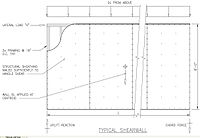
Photo from wikipedia
Abstract Steel braced frames are commonly used in steel structures to control and improve the seismic performance of the structures under severe lateral forces such as an earthquake. So, providing… Click to show full abstract
Abstract Steel braced frames are commonly used in steel structures to control and improve the seismic performance of the structures under severe lateral forces such as an earthquake. So, providing better formability would help designers to achieve their desire seismic performance level. This study is focused on utilizing steel curved dampers in the ductile braced frame instead of using knee elements to provide better energy dissipation, frame strength, and elastic stiffness during cyclic loading. Five dampers with identical length and thickness, yet with various angles (30°, 60°, 75°, 90°, and 120°) and eccentricities have been used in steel braced frame. A cyclic loading protocol has been applied to the frame to assess dampers impacts on the structural characteristics of the frame. The final results show that higher frame strength and energy dissipation have occurred by increasing damper angle from 30° to 60°, yet increasing the angle to more than 75° reverses the final results. Hence from all five dampers, the most effective one for increasing both frame strength and energy dissipation in steel ductile braced frame is the 60° damper. The significant improvements in seismic performance of ductile braced frames have also been observed by utilizing proposed steel curved dampers.
Journal Title: Structures
Year Published: 2021
Link to full text (if available)
Share on Social Media: Sign Up to like & get
recommendations!